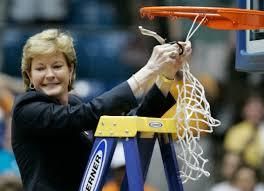One year ago, Pat Summitt—former University of Tennessee head women’s basketball coach—passed away at age 64.
As a point guard, I have always loved what Pat stood for: hard work, forward focused energy, intensity, compassion, and so much more. For those who didn’t follow her career like me, Pat was the all-time winningest basketball coach among men and women in NCAA history with 1098 wins. She retired from coaching in 2012 after a diagnosis of early-onset Alzheimer’s disease.
In 2013, many of Pat’s fans got to celebrate her incredible life in sports by watching ESPN’s documentary series “Nine by IX” on Title IX, the federal law that requires equal opportunity for girls and women in school and college sports programs. Pat’s episode was affectionately named Pat Summitt XO. How fabulous to use the hug and a kiss, a metaphor for offense and defense symbols on a coaching board?!
The Nine for IX piece is a beautiful testament to Pat’s life spoken by herself, her son, her student athletes, coaches, and others whose hearts she deeply touched. Seeing Pat’s life, and the strength of Pat’s conviction, on screen brought me to tears of joy and inspiration.
Why Pat Summitt’s Story is So Important
In short, Pat almost single-handedly brought the sport of women’s basketball to a commercially successful and publicly revered level.
I remember being in Pat’s arena—Thompson Bolling Arena (renamed “The Summitt” in her honor)—in 1992 and watching Jennifer Azzi, a Stanford University All-American point guard, take apart an opponent in the Final Four. I remember it well because that was the day I told my friend Megan who attended the game with me that I wanted to be part of changing women’s sports at a national level. I was so disheartened that the arena was not filled to capacity with spectators.
At that time 25 years ago, the advertising hype for the NCAA tournament was minimal. Tickets were still not a sell out for the NCAA Women’s Final Four. And this was well before the buzz of the extraordinary women’s Olympic team’s accomplishments, the UCONN/STANFORD/TENNESEE/BAYLOR/NOTRE DAME rivalries, or the start of the ABL and WNBA that would bring commercial success to women’s basketball. But women’s coaching and basketball would rise to an unprecedented level as Pat, alongside Joan Cronan (the women’s athletic director at Tennessee), pursued any and all opportunities to build a dynasty.
Pat created team after team of players, oodles of fans, and administrators who, over almost three decades of coaching, stood by her through thick and thin. This says a lot about her leadership style.
Her presence on the court and on the national stage was memorable. Her strength was sexy. The pantsuit and broad shoulders along with her “take charge” hair and hyper-focused eyes gave her an attractive and energetic physical intensity. Pat was never characterized as “feminine” or non-assertive, yet the highly maternal expressions she shared with students, relating both to the athlete and the character inside each of her players, shines through in video stories and tributes since her passing in 2016.
In addition to her 1098 wins, Pat coached 161 former players and graduates of the University of Tennessee, lifelong pupils in the School of “PAT” (I coin it, “Purposeful Attitude Training”). 48 of them stayed in basketball and are coaches today. I doubt there are many other coaches who can report that more than 30% of their players followed in their footsteps to pursue coaching careers.
And prior to her passing in 2016, Pat used her voice, her broad shoulders, and her celebrity to shed light on another underserved and invisible population—people with Alzheimer’s. Pat’s legacy is the perfect example of what it means to be a woman, an athlete, and a leader.

Honoring Pat’s Legacy
When Pat started coaching in 1974 (1098 wins ago! Have I mentioned that yet?), the profession of women’s coaching across all sports lacked substantial salaries, summer camps, television contracts, sponsorships, and other lucrative perks. While Division I women’s basketball coaches today still make 50% less than their male counterparts, in the 70s their salaries were little more than what a part-time graduate assistant coach might make today.
Now we’re in 2017 and women play professionally in the WNBA, which helps elevates the game at all levels. Nevertheless, sports pay parity is missing in the WNBA and NBA with the women averaging $72,000 and the average NBA player making $10 million. And we know about Venus Williams’ fight for parity in the Grand Slam events of tennis (the first program in the ESPN Nine for IX series).
A little over 50 years after the implementation of the Equal Pay Act, women athletes may be gaining some momentum towards pay equity. But there is still so much more work to be done.
We can hope that women athletes and leaders in women’s college basketball will own a set of humanist values rather than mimic the current male model of excess. Many Division I women’s programs are exposed to the men’s “arms race” in college sports of preferential treatment (with coaches being paid more than 90% of every professor on campus). Will women athletes feel that the world owes them homage or will they have appreciation for the opportunities sport has given them and want to give back to those following in their footsteps? Will they stand up and question the largesse of college sports where the highest paid public employee in 39 states is a football or a basketball coach? How do we ensure that this and future generations of female athletes continue to give back to the sport through coaching, representing women athletes, writing checks for season tickets, staying connected to the fans, and making sure that we treat women athletes with respect?
Women in sport are being more accepted as powerful leaders and advocates in the general population. Most major news stations covered the US Women’s Soccer Equal Pay campaign, and commercials are beginning to include female athletes as sponsors or leading figures in ads. The USA Women’s Hockey team fought for equal pay as Olympic athletes.
In the U.S., the rights women learn as competitive athletes are not talked about publicly until issues like coach sexual harassment or pay equity are brought to light. At Women Win (an organization for which I serve on the Board of Directors), we blend women’s sports and women’s rights and publicly name how sports offers economic security and embodied leadership where girls know how to say “No” to what they know is not healthy for them (child marriage or exploitation, sexual abuse by coaches, lack of access to education or economic security).
What would sport for women truly be like if we embraced the reality that sport is a feminist tool in our American culture? Without sports (and Title IX) we wouldn’t have the contributions of the 80% of senior women in Fortune 500 leadership or the activists leading in sports, philanthropy, elected office, the law, and beyond.
Now let’s zoom out and take a look at the big picture. Female sport leaders bring something different to the table in that they have come through and to sport from a distinct perspective. More often than not, and especially in Pat’s time, women have entered sport without the fanfare of support from the media, their families, fans or others. Women have fought for acceptance to take up space, use their bodies with fierce intention and strength, and to compete. Most have had to address some conversation on sensuality or sexuality whether internally or externally. These are all unique experiences to being a woman in sports. From these experiences, women often bring more graciousness and compassion to athletic competition and to leadership and business. This is clearly a competitive advantage.
People in decision-making positions must continue to hire and promote women and appoint women to be members of boards of directors. Investing in women who can “own their power” in body, mind, and spirit as Pat did so beautifully is a good thing and only makes companies stronger. For decades, research has shown that companies with women in leadership and on corporate boards have a higher return on equity. Female leaders, and male allies who are willing and able to bring a gender lens to their work, are developed over time. When we honor and recognize the achievements of successful and powerful women throughout history, we invite others to follow their lead and make it easier for them to do so. We need to see it to be it. I saw Pat and she shaped my leadership voice and so many others.
Now more than ever we need to continue to groom more women to take advantage of Pat’s legacy and stand for equity and healthy competition. She challenged us all, men and women alike, to be the best versions of ourselves, even as she declined in health.
It is fabulous when women take up space with not only their voices, but their entire being. Pat helped build nothing short of a revolution within women’s sports. In salute of her legacy, let us channel her physical presence to embody the leadership we need to speak up for our rights in our own arena, wherever that may be. Let’s keep celebrating Pat’s presence while ensuring that the women’s sports movement continues to bridge the worlds of gender, sensuality, leadership, and power.
